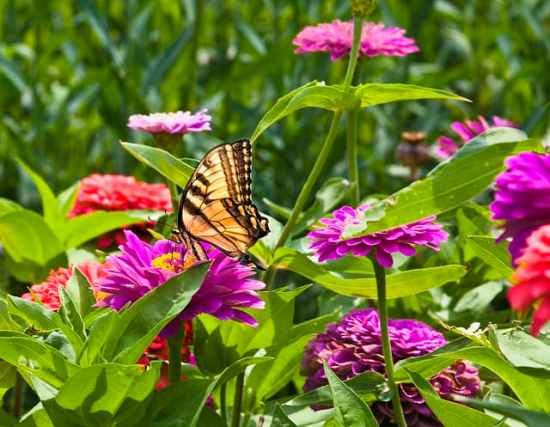
Gardeners love zinnias! They are showy, bright, and easy to grow. They continue to bloom from early summer until the first frosts of fall, and most varieties make lovely cuttings to enjoy in a vase or to share with a friend.
Zinnias (Zinnia elegans) are happy little annuals that have flat or pom-pom looking flowers with petals that overlap either in a single layer or a double layer. They are available in every color with the exception of blue. There is a large variety of sizes to choose from too, from large and tall zinnias that grow up to 4 feet, to small and bushy versions that grow just 1 foot tall.
Zinnias are warm-loving flowers. They are indigenous to Mexico where they were grown as far back as the 1500s by the Aztecs. They are perennials in their warm, native climate.
Zinnias made their way to Europe in the 1700s. Europeans were the first to begin to breed zinnias for their appealing characteristics. Eventually they arrived in the United States where several award-winning varieties were developed. Today, there are hundreds of varieties of zinnias to choose from, and one is sure to fit perfectly into your garden scheme.
How to Grow and Care for Zinnias
Zinnias can be started indoors from seed four weeks before the last frost in your region. However, they are tender annuals, and they don’t always transplant well. A preferred method for starting your zinnias is to plant them direct in your garden soon after the danger of frost has passed.
Your zinnias will grow best in moist, rich soil. Whether you choose a small or a large variety, they will need plenty of personal space. Plant your smaller varieties at least 8 inches apart and your larger, branching varieties at least 14 inches apart.
Zinnias love full sunshine. They enjoy just the right amount of water, too. Soil that is moist to the touch will suit your zinnias perfectly. When you water your zinnia plant, try to water at the root. Or water them early in the day so their leaves have plenty of sunshine to dry them.
Once your zinnias bloom, you will be able to enjoy cutting them often. In fact, with most varieties, the more you cut, the more they will bloom. You don’t have to keep from enjoying the pretty blossoms in a vase indoors for fear that once you cut, your outdoor color will be gone. That might be the case with some annuals, but not with zinnias.
If you choose not to cut them, make sure to deadhead often to keep those colorful blooms coming.
Pests and Problems
Because zinnias are originally a tropical flower, they are sensitive to cold. If you live in a cool region, choose a hardier variety.
Zinnias foliage is also prone to fungi and molds when they are exposed to a lot of moisture. To avoid this problem, give each zinnia plant plenty of space to allow for air circulation. Again, water this plant low to avoid allowing water to sit on the leaves more than necessary.
Zinnias may struggle with spider mites, mealy bugs and caterpillars, too. Since they are annuals, they will probably make it through the blooming season in spite of these unwanted guests. If a plant becomes badly infested, remove it to salvage your other healthier plants.

Varieties to Consider
With hundreds to choose from, be sure to select a variety that is well-suited for your garden and your taste in color and size. Here are a few special cultivars we felt are worth looking for!
- ‘Zahara‘ is a drought- and disease-tolerant variety. It is a good choice for containers.
- ‘Dreamland‘ is a dwarf-sized plant with giant-sized blossoms. The blooms come in wide assortment of colors, and are available in a mixed color option, too.
- ‘Benary’s Giant’ was developed for cutting. With long, branching stems, it makes a nice burst of color to plant in the back of your garden.
To learn more about growing zinnias, check out the following links:
Zinnias – University of Illinois Extension
2011: The Year of the Zinnias – National Gardening Bureau
Creative Commons Flickr photo courtesy of Muffet

Do you have a very tall variety that includes one called Shanghai? I had these for ~2years, then have been unable to find them again – not even seeds. Their colors were yellow, dark red, lavender. Thank you for your time.